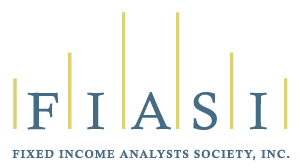Induction Speech for Andrew J. Kalotay
Inducted December, 1997
Immediate Past-President John Malvey presented FIASI’s Hall of Fame award to Andrew J. Kalotay, Ph.D. Mr. Malvey’s induction speech follows.
Our profession is tremendously indebted to Andy Kalotay, our first Fixed Income Analyst Society inductee of the day and fourth overall since the inception of the FIASI Hall of Fame two years ago.
The FIASI Board of Directors unanimously voted Andy's induction into the Hall of Fame based on his remarkable career as well as his outstanding long-term service to the Fixed Income Analysts Society.
On a personal basis, I am especially pleased to have the honor of making this induction. I have known Andy for about 10 years. During this period, he has personally tutored and encouraged me like so many of you, and he has saved me on several FIASI annual bond conferences with his wonderful ideas and his incredible range of friendships throughout the financial and academic communities. Indeed, after watching Andy hold court at a 2000 strong Financial Management Association conference, I wonder if Andy doesn't know every finance
academic in the U.S.
Andy's amazing career alone would easily qualify him for induction. Andy is the preeminent pioneer and world's leading authority on the practice of liability management as well as the quantitative evaluation of corporate fixed-income obligations. Andy also has made numerous contributions to the quantitative analysis of a wide-range of other fixed-income obligations such as derivatives, municipals, and adjustable-rate mortgages. His teams also provided seminal work on multi-currency optimization.
Andy's intellectual development has many roots. Andy left Hungary for Canada at age 16. A year later, he already was rated the No. 3 chess player in Canada and competing for his new country in international chess tournaments.
After graduating from Queens College in Canada and gaining his Ph.D. in statistics from the University of Toronto, Andy entered the math department at think-tank Bell Labs. By the mid-1970s after having been alerted to an intriguing optimization problem in applied finance, Andy migrated from Bell Labs to the Treasury Department at parent AT&T to deal with a major concern. AT&T, the largest combined issuer in corporate America at the time, was confronted with a refinancing dilemma. Should AT&T authorize its Bell subs to refinance their
outstanding long-term debt at current interest rates or wait for possibly lower interest rates in the future? Andy's analysis ultimately led AT&T to undertake the very first-economically induced tender by an issuer.
So began Andy's track to liability management and the quantitative analysis of corporate obligations. By 1979, Andy already had published a prize-winning article in Interfaces on how to deal with the refunding problem. By the early 1980s, Andy was engaged by Salomon Brothers to deploy his insights. He eventually became the director of the Bond Portfolio Analysis Group, which pioneered a whole range of solutions to both investors and issuers alike.
The 1980s were a period of great innovation across the global capital markets, especially at industry research pioneer, Salomon Brothers. By 1985, option-valuations models were finally applied genetically across the fixed-income capital markets.
The mid-1980s, especially 1986, also brought another massive downward shift in U.S. interest rates. Globally, there were massive waves of issuer refundings.
But there were still were unsolved questions. How should issuers properly analyze their call and tender decisions?
Up until the mid-1980s, the analysis was a simple mechanistic PV savings per bond, using a static interest rate assumption. Typically, a corporate finance intern or associate, plucking the Treasury yield on the date of the analysis, dispatched a simple spreadsheet to an assistant treasurer. If the issuer also happened to be a publicly traded corporation, then the analysis really became fancy. The PV savings were then dressed up as savings per share. Operating solely on such insights that a potential refunding might save a few pennies a share, many issuers, especially in the utility realm, would make major decisions about refinancings, liability structure, and effectively their capitalization ratios.
Combining his quantitative skills with the tactical instincts of a world class chess player, it was Andy Kalotay who formulated the methodological framework to move beyond this simplistic analysis. By comparing the then newly-calculated embedded option value per fixed income security to its PV savings per security, Andy derived his "call-efficiency ratio" and "tender-efficiency ratio" to determine whether a security should be called or tendered. If this ratio tracked above 90%, then a security should be called or tendered by the issuer. Importantly and unlike many at the time, Andy's analysis also incorporated all the often overlooked subtleties of pre and post-tax treatment.
Andy also introduced another innovation, which differentiated his analysis. In the mid-1980s, more than half of all callable structures in the U.S. also included a sinking fund. But until Andy came along, option valuation models completely ignored sinking funds. Effectively, the embedded option value of all sinking fund structures was understated, sometimes dramatically so. (Parenthetically, most popular models still ignore this option).
In earning the title, "Dr. Sinking Fund," it was Andy Kalotay who devised a solution to deal with the embedded optionality of sinking funds and who also unbundled the sinking fund into its core components: the acceleration; delivery; and designation options.
From this framework, it was a straightforward leap to move to the analysis of optimal new issue structures. Using Andy's methodology to create an efficient frontier for an issuer, issuers for the first time could more scientifically rank the potential merits of the full range of new issuance options from short, optionless bullets, through intermediate bullets, conventional longs with classic call and sinking fund options, singular and multiple puts (at par, at discount, at a premium) and even into the 1990s resurrection of the 40s, half centuries, and Century structures.
By the beginning of 1990, Andy moved on to found his own firm, Andy Kalotay Associates, where I am pleased to report that I was Andy's very first and very pleased client.
During the 1990s, Andy's firm has been engaged by nearly all of Wall Street as well as by several major Canadian and European firms. His list of issuer clients numbers in the dozens around the world and ranges from major supranationals to all manner of utility and industrial firms. Some major investors also are subscribers as well as some major rating agencies.
But Andy is far more than financial innovator and entrepreneur. Many of us think of him as scholar and teacher at heart. While perhaps too many practitioners hold back their insights for proprietary advantage, Andy, along with various co-authors like Bill Boyce, George Williams, Bruce Tuckman, Dennis Logue, Doug Howard, and Frank Fabozzi, unleashed a torrent of articles explaining his methodology.
Not surprisingly, nearly every major issuer and investment-banking firm now uses Andy's terminology and framework in liability management analysis. In his firm's literature, Andy's cites advising on about $60 billion of debt transactions. This may be the direct neighborhood but it's a tremendous undercount. Indirectly, including all the decisions made within the context of his framework, Andy's transactions number in the hundreds of billions.
Somehow in the midst of all of these activities, Andy has found time to teach courses at Wharton, Columbia, and Fordham graduate business schools. But his greatest academic achievement was serving as founder and the first Director of the Center for Technology & Financial Services at Polytechnic University in Brooklyn, one of the first institutions in the world to offer a masters degree in the rapidly-growing field of financial engineering. After giving up the administrative duties of directorship this past summer, Andy still serves on the faculty.
And Andy's chess career has not been idle. Although no longer competing on a regular basis, Andy does enjoy levelizing certain very prominent Wall Street egos on a chessboard from time to time. And in terms of awards, today's ceremony may well rank second on Andy's list of notable accomplishments. To his sheer delight, a prominent chess magazine several years ago bestowed upon him an award for authoring the very best published chess puzzle for four pieces.
Somewhat rare in academia and rarer still on Wall Street, Andy has displayed tremendous generosity and intellectual altruism throughout career. Over the years, he has served as a kind of intellectual matchmaker. He has encouraged academics and practitioners alike to collaborate, to write, and to present on a wide variety of topics in applied and theoretical finance. His coop in Greenwich Village has become as a kind of late 19th / early 20th Century salon, with all manner of interesting people frequently showing up just to chat.
Over the years, he has frequently deferred speaking engagements and even article requests to colleagues. Not to shed workload, but so that his colleagues could boost their own visibility and advance their careers.
There are many, many individuals scattered throughout the global capital markets who owe a great measure of their subsequent career success to Andy Kalotay. Indeed, just a few months ago, the liability management departments of several major Wall Street firms honored Andy at a private dinner.
And on the personal side, for those of you who don't yet have the privilege of knowing him, there's also a much lighter side to Andy, who possesses a tremendous sense of humor, especially self-depreciating humor. For a man of such vast and rare quantitative and chess skills, Andy's personal technology skills are stunningly incongruous. It would be hard to imagine any real quant who has lost more computer files, corrupted or completely vaporized more hard drives than Andy over the past decade.
Andy also is still learning about net navigation. Recently, he sought out a new chess forum on the net. Striking gold so he thought, he found a topic of great chess interest, "ideal mates." Unhappily, the first reference turned out to be a dominatrix located in Germany. Supposedly, Andy was unable to determine whether she also had Marv Albert's phone number in her book.
And please don't let Andy get anywhere near a fax machine, especially if you a confidential presentation that should only go to one party and not the world.
Finally, as a current FIASI board member and past FIASI president, it is my delight to induct for the very first time a former FIASI President and still current member into our Hall of Fame.
Applying the same energy and enthusiasm to FIASI, Andy quite naturally was just about the finest President in the history of our organization. During his tenure, Andy enlarged the membership base and broadened the vision of FIASI to include more quantitative members.
In the ensuing years, Andy undoubtedly has contributed more to our organization than any other ex-President. His firm has been a sustaining member, bond conference sponsor, and even has supplied the server to provide a FIASI net site.
Andy Kalotay: advisor, practitioner, innovator, financial engineer, scholar, educator, outstanding FIASI President and ongoing contributor, and friend to our profession and to many of us personally in this room. On behalf of our membership and our profession, it is my great honor to present you with this Tiffany Crystal, symbolic of your 1997 induction into the Fixed Income Analyst Society Hall of Fame.








